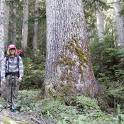Black Hemlock Tree Information
Images of Black Hemlock:






Black Hemlock grows in the following 8 states and provinces:
Alaska, Alberta, British Columbia, California, Idaho, Montana, Oregon, WashingtonInformation about Black Hemlock:
The Tsuga Mertensiana is commonly known as the Alpine Hemlock, Black Hemlock, Hemlock Spruce as well as Mountain Hemlock.
The currently accepted scientific name for mountain hemlock is Tsuga mertensiana (Bong.) Carriere . Mountain hemlock in the Siskiyous from the Oregon-California border south were recently classified as Tsuga mertensiana spp. grandicona Farjon, in recognition of the generally larger cones of trees in this region . All others are classified as Tsuga mertensiana spp. mertensiana. There are no recognized varieties or forms. Mountain hemlock will hybridize with western hemlock (T. heterophylla) .Mountain hemlock occurs along the crest of the Sierra Nevada; the Coast Ranges and Cascade Range in Oregon; the Cascade Range and Olympic Mountains in Washington; the northern Rocky Mountains in Idaho and western Montana; the Insular, Coast, and Columbia mountains in British Columbia; and in southeast and south-central Alaska . In California it is also locally abundant in the Klamath Mountains. The extreme southern limit of mountain hemlock is near Silliman Lake in Tulare County, California .Mountain hemlock commonly occurs as a dominant or codominant in high-elevation alpine or subalpine forests. In western Washington and Oregon, the mountain hemlock zone is the highest forested zone . Mountain hemlock is often codominant with Pacific silver fir (Abies amabilis) . One of the most widespread mountain hemlock communities is the mountain hemlock-Pacific silver fir/big huckleberry (Vaccinium membranaceum) type found in British Columbia and the Oregon and Washington Cascades. In the Rocky Mountains, the mountain hemlock/beargrass (Xerophyllum tenax) habitat type is generally found on south slopes and is characterized by a high cover of beargrass with big huckleberry and grouse whortleberry (V. scoparium) as common associates. A similar Pacific silver fir-mountain hemlock/beargrass association is found in Oregon . Published classifications identifying mountain hemlock as a dominant or codominant are as follows: Forest types of the North Cascades National Park Service complex . Preliminary plant associations of the Southern Oregon Cascade Mountain Province . Preliminary plant associations of the Siskiyou Mountain Province . Plant association and management guide for the Pacific silver fir zone . Forest habitat types of northern Idaho: A second approximation . Classification of montane forest community types in the Cedar River drainage of western Washington, U.S.A. . Preliminary forest plant association management guide. Ketchikan area, Tongass National Forest . Subalpine plant communities of the western North Cascades, Washington . Alpine and high subalpine plant communities of the North Cascades Range, Washington and British Columbia . Fire ecology of western Montana forest habitat types . Forest vegetation of the montane and subalpine zones, Olympic Mountains, Washington . Natural vegetation of Oregon and Washington . The forest communities of Mount Rainier National Park . Plant associations of south Chiloquin and Klamath ranger districts-- Winema National forest . Vegetation and environment in old growth forests of northern southeast Alaska: a plant association classification . Forest habitat types of Montana . Preliminary classification of forest vegetation of the Kenai Peninsula, Alaska . Preliminary forest plant associations of the Stikine area, Tongass National Forest .Some of the information provided here is attributed to:Tesky, Julie L. 1992. Tsuga mertensiana. In: Fire Effects Information System, [Online]. U.S. Department of Agriculture, Forest Service, Rocky Mountain Research Station, Fire Sciences Laboratory (Producer). , available at the USDA Fire Effects Information System (FEIS) website